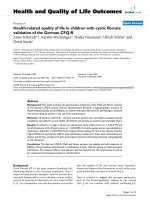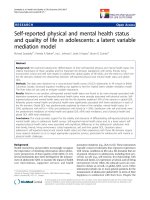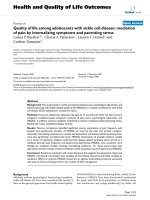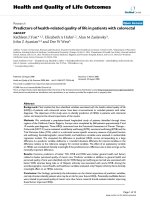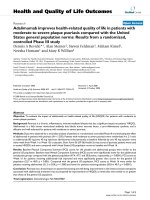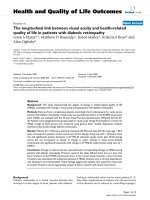Parental Stress and Perceived Quality of Life in Adolescents with Asthma
Bạn đang xem bản rút gọn của tài liệu. Xem và tải ngay bản đầy đủ của tài liệu tại đây (418.7 KB, 75 trang )
Parental Stress and Perceived Quality of Life in Adolescents with Asthma
by
Elise Howard, BS
A Thesis
In
HUMAN DEVELOPMENT AND FAMILY STUDIES
Submitted to the Graduate Faculty
of Texas Tech University in
Partial Fulfillment of
the Requirements for
the Degree of
MASTER OF SCIENCES
Approved
Malinda Colwell, PhD
Committee Chair
Sybil Hart, PhD
Michael McCarty, PhD
Fred Hartmeister
Dean of the Graduate School
May, 2009
Texas Tech University, Elise Howard, May 2009
ACKNOWLEDGEMENTS
I would like to thank everyone who has helped and encouraged me during the
process of writing and completing my thesis.
I would like to express my deepest gratitude to my chair, Dr. Malinda Colwell, for
her guidance, encouragement, support and feedback. I would also like to thank my
committee members, Dr. Sybil Hart and Dr. Michael McCarty for their direction and
recommendations in writing my thesis. I deeply appreciate the amount of time and
energy they put forth in helping me complete my thesis.
A special note of appreciation and gratitude goes to the Pediatric Pulmonologist’s
office staff and especially Diane, for their assistance in the distribution and collection of
the data. Without them, this study would not have been possible.
I would also like to express my gratitude to Travis and my family and friends for
their support and encouragement as I completed this project. Their circle of support
continued my efforts and kept me positively focused on the end result. A special thanks
to my mother and father for enabling me to pursue my goals, and for providing me with
the foundation I needed.
ii
Texas Tech University, Elise Howard, May 2009
TABLE OF CONTENTS
ACKNOWLEDGEMENTS
ii
ABSTRACT
v
LIST OF TABLES
vi
CHAPTER
I.
INTRODUCTION
1
II.
LITERATURE REIVEW
5
Health Related Quality of Life in Children
with a Chronic Illness
5
Health Related Quality of Life in Children
with Asthma
8
Parental Stress and Chronic Illness
12
Parental Stress and Asthma
19
Purpose and Hypotheses
22
III.
METHODS
23
IV.
RESULTS
27
V.
DISCUSSION
38
Study Limitations and Future Directions
41
Conclusions
42
REFERENCES
44
iii
Texas Tech University, Elise Howard, May 2009
VI.
APPENDICES
52
A: Parent and Adolescent Consent Forms
52
B: Parent and Adolescent Instruction Letters
55
C: Family Information Form
58
D: Pediatric Inventory for Parents
62
E: Paediatric Asthma Quality of Life Questionnaire (S)
65
iv
Texas Tech University, Elise Howard, May 2009
ABSTRACT
This study examined the relationship between parental stress and quality of life in
adolescents with asthma. It was expected that more parental stress would be related to
lower quality of life scores and that mothers and fathers would experience different
amounts of stress and stress in different areas. The sample included 39 adolescents with
asthma and one of their parents. Data were collected from parents assessing parental
stress, their child’s severity of asthma, and demographic information. Adolescents
reported on their perceived quality of life. A relationship was found between parental
stress and quality of life, with significant relationships for parents of daughters. Severity
and parental stress also were found to be related.
v
Texas Tech University, Elise Howard, May 2009
LIST OF TABLES
1.
Descriptive Statistics
28
2.
Correlations Between Adolescent Quality of Life and Parental Stress for
30
the Total Sample
3.
Parental Stress and Quality of Life Variables
32
4.
Correlations Between Adolescent Quality of Life and Parental Stress for
33
Boys
5.
Correlations Between Adolescent Quality of Life and Parental Stress for
34
Girls
6.
Correlations Between Adolescent Quality of Life and Parental Stress for
Girls Controlling for Severity
vi
36
Texas Tech University, Elise Howard, May 2009
CHAPTER I
INTRODUCTION
There has been a long history of research on parental stress and its impact on
children. Much of this research has focused on normally developing and healthy
children. In general, the effect of parental stress on children includes a negative impact
on the mother-child relationship, the child's competence, and on maternal warmth
(Roberts, 1989). However, the effects of parental stress on children’s behavior can be
mediated by parenting. Specific findings from this literature include that parental stress
in the areas of loss and disappointment is associated with lower levels of parental warmth
(Roberts, 1989). Maternal loss and maternal disappointment are both associated
negatively with children’s general competence. The negative impact of loss on both
mothers’ and fathers’ responsiveness and warmth shows that the effects of grief and
bereavement are among the most severe and long lasting that parents experience. Finally,
the effects of stress and social networks are most evident in groups that experience high
levels of stress.
Some research on the impact of parental stress on children has been conducted on
families with children from special populations, including children with autism (BakerEriczen, Brookman-Frazee & Stahmer, 2005), intellectual disabilities (Hassall, Rose, &
McDonald, 2005), developmental delays (Webster, Majnemer, Platt, & Shevell, 2008),
and children who are deaf (Hintermair, 2006). Other research has focused on parental
stress among parents with chronically ill children (e.g., Frank, Wagner, Laub, Freeark,
1
Texas Tech University, Elise Howard, May 2009
Breitzer, & Petters,1991; Dellve, Samuelsson, Tallborn, Fasth, & Hallberg, 2005),
including children with heart disease (Uzark & Jones, 2003), duchenne muscular
dystrophy (Nereo, Fee, & Hinton, 2003), diabetes (Lowes & Lyne,1999), and eczema
(Faught, Bierl, Barton, & Kemp, 2007). In general, parents of chronically ill children are
not only exposed to the everyday stressors of parenting, but they are also exposed to
stressors related to their child’s illness or condition (Burke, Kauffmann, Harrison, &
Wiskin, 1999).
Knowing that parental stress can affect many different aspects of a child’s life,
what is the relationship between parental stress and the child’s quality of life? Of
particular interest for this project is how parental stress affects the quality of life in
children with the specific chronic illness of asthma.
Asthma is an inflammatory condition of the lungs that makes it difficult to breathe
(American Lung Association). Asthma is the most common childhood chronic illness, it
affects the lives of 6.8 million children in the United States, and it is the third leading
cause of hospitalization among children under the age of 15 (American Lung
Association). Asthma may be managed by medication, as well as by controlling factors
in the environment, education, and close monitoring.
Quality of life issues among children with asthma have been studied (e.g., Chiang,
2005; Juniper, Guyatt, Feeny, Ferrie, Griffith, & Townsend, 1996), and a quality of life
measure among children with asthma has been devised (Juniper et al., 1996). In general,
children with chronic illnesses typically have a lower quality of life than healthy children
(Grootenhuis, Koopman, Verrips, Vogels, & Last, 2007). However, there is a gap in the
2
Texas Tech University, Elise Howard, May 2009
literature as to the role that parental stress plays in the quality of life in children with
asthma.
Parents of children with a chronic illness face unique stressors (Burke et al.,
1999), the stressors and tasks the families face do not occur in a fixed order, and
seemingly unrelated tasks and stresses can cluster. Among families with a child with a
chronic condition, typical child rearing and other family issues can be more difficult to
solve and more complex than for families without a child with a chronic illness.
Unrelated stressful events or changes in the status quo of the child or the family may also
trigger the recurrence of stressors. Families with a child with a chronic illness had unique
stressors, and the unpredictable nature of these stressors calls for added family caution,
which in itself can be a stressor. Burke et al. (1999) outlined specific areas in which
families with a child with a chronic condition experience stress. Most of the families
reported that expensive essentials were needed to treat or care for a child with a chronic
condition. Many families also noted that friends, family, and self-help groups played a
vital role in helping them cope. However, parents mentioned that they found it stressful
to initiate and participate in supportive activities for their child.
Even a minor child illness may be a source of stress for parents, and more serious
illnesses are related to more stress (Frank et al., 1991). Mothers of children with a severe
history of acute illness during their first three years of life report more parenting stress
than mothers of healthier children. Mothers of children with a history of more severe
illness were more likely to report a related cluster of stresses. These stresses include
more role restriction, more social isolation, and more health problems. Considering that
3
Texas Tech University, Elise Howard, May 2009
parents of children with minor illness experience increased amounts of stress, it can be
assumed that parents of children with a chronic illness will also experience stress. It may
be that maternal stress for those with children with serious illness is reported more
frequently than maternal stress among mothers of healthy children. Additionally,
studying the effects of parental stress, particularly the mother’s level of stress, may reveal
a pattern that is linked more specifically to the disease, rather than simply to the serious
illness experienced by the child.
The present study examines parental stress and perceived quality of life in
children with asthma. First, parental stress is assessed to see the nature and amount of
stress that parents of children with asthma face. Parental stress was assessed by a self
report survey, and children completed a questionnaire about their quality of life. The
Pediatric Inventory for Parents (PIP; Streisand, Braniecki, Tercyak, & Kazak, 1991) was
used to assess parental stress. The PIP examines parenting stress in the domains of
communication, emotional distress, medical care, and role function. Second, perceived
quality of life in children with asthma was measaured. The Pediatric Asthma Quality of
Life Questionnaire (Juniper et al., 1996) addresses the areas of activity limitation,
symptoms, and emotional function, assesses children’s quality of life. Children in this
sample are between the ages of 11-17, which is the age necessary to self-administer the
Pediatric Asthma Quality of Life Survey.
4
Texas Tech University, Elise Howard, May 2009
CHAPTER II
LITERATURE REVIEW
The chief purpose of this literature review is to look at research related to parental
stress and quality of life in children with a chronic illness, more specifically asthma.
First, quality of life in children with a chronic illness and children with asthma will be
reviewed. Next, parental stress and chronic illness and parental stress and asthma will be
examined. By reviewing these areas, questions will be identified connecting parental
stress and quality of life in children with asthma.
Health-Related Quality of Life in Children with a Chronic Illness
Health-related quality of life (HRQoL) in children is receiving increasing
recognition as an important health outcome. Grootenhuis et al. (2007) stated that healthrelated quality of life refers to the specific impact an illness, injury, or medical treatment
on an individual’s quality of life.
According to Grootenhuis et al. (2007) the effects of childhood disease and the
treatment of childhood disease frequently enhance the child’s dependence on his or her
parents. The purpose of this study was to explore the prevalence and nature of healthrelated quality of life troubles in children with various chronic diseases. Another aim of
this study was to identify chronically ill children who are at risk. Participants in this
study were between the ages of 8 and 11 and had a chronic condition. These conditions
include: congenital heart disease, asthma, cancer, survivors of severe meningococcal
5
Texas Tech University, Elise Howard, May 2009
disease, celiac disease, juvenile chronic arthritis, and children with a capillary
haemangiomas. The TNO AZL Children’s Quality of Life questionnaire (TACQoL;
Vogels, Verrips, & Koopman, 2000) was used to measure health-related quality of life.
This questionnaire covers seven domains: physical functioning, autonomy, motor
functioning, cognitive functioning, social functioning, positive emotions, and negative
emotions. Each domain contained eight items. In the domain of motor functioning,
children with congenital heart disease, cancer, and asthma had a lower health-related
quality of life than healthy children. Physical functioning and autonomy were affected in
over 40% of the children with asthma. The results of this study show that difficulties in
health-related quality of life can be specific to the diagnosis, so pediatricians should pay
attention to disease-specific problems. This study also shows that quality of life can be of
potential value in comparing outcomes of interventions and to better understand the
child’s problems and specific situation and point of view.
Childhood disease also can decrease involvement in peer activities. These
changes can have unfavorable effects on HRQoL. Studies have shown that children with
a chronic illness have problems in several domains of HRQoL (Varni, Limbers &
Burwinkle, 2007). Varni et al. (2007) compare health-related quality of life scores among
ten pediatric chronic disease clusters and thirty three disease categories or severities by
using the PedsQL 4.0 Generic Core scales from the viewpoints of the patients and the
parents. The participants consisted of more than 2,500 pediatric patients across several
disease clusters. Of the pediatric patients, 165 had asthma, 572 had cancer, 426 had
cardiac diseases, 245 had cerebral palsy, 331 had diabetes, 287 had gastrointestinal
6
Texas Tech University, Elise Howard, May 2009
condition, 63 were obese, 310 had psychiatric disorders, and 393 had rheumatologic
conditions. Participants were ages 5 to 18.
This study used the Pediatric Quality of Life Inventory Version 4.0 (PedsQL 4.0;
Varni, Burwinkle, Rapoff, Kamps, & Olson, 2004) to measure health-related quality of
life. The PedsQL is a 23 item scale covering four domains. These include: physical
functioning, emotional functioning, social functioning, and school functioning. The scale
is made up of child self-reports and parent proxy-reports. The parent scale and the scale
for children ages 8 to 18 uses a 5-point Likert scale, and the scale for children ages 5 to 7
uses a simplified 3-point Likert scale with happy and sad faces. For parents and children
ages 8 to 18 the PedsQL was self-administered. For children ages 5 to 7 and children
who could not read or write, the PedsQL was interview-administered. When the surveys
were mailed, the parents were instructed to complete the survey separately from their
child if they were age 8 to 18. If their child was ages 5 to 7 the parents were instructed to
assist their child in completing the survey, after they had completed their own report.
Overall, both patients and parents of the children in all disease clusters reported
significantly lower health-related quality of life than healthy children and their parents.
Also across the disease clusters, patients and parents reported significantly lower
psychosocial health than healthy children and their parents. As a whole, the patients in
the disease clusters also reported significantly lower emotional, social, and school
functioning. This study showed that there are differential effects of pediatric chronic
conditions on patient health-related quality of life across these disease clusters from the
perspective of both the parents and the patients. Patients with diabetes, gastrointestinal
7
Texas Tech University, Elise Howard, May 2009
conditions, cardiac conditions, asthma, obesity, end stage renal disease, psychiatric
disorders, cancer, rheumatologic conditions, and cerebral palsy reported more impaired
health-related quality of life than healthy children. In general, the parents’ report agreed
with the patients in that the patients in these disease clusters did have more impaired
health-related quality of life than did healthy children.
Research has shown that children with a chronic illness have a negative impact on
quality of life. While the impact varies across diseases and severity, it remains clear that
something is affecting these children’s quality of life. However, it is unclear as to what
factors are influencing their quality of life.
Health-Related Quality of Life in Children with Asthma
Asthma has many different effects on a child’s life. Many of these effects can be
negative, and can inhibit their quality of life. Benedictis and Bush (2007) examined the
challenges of asthma in adolescence. The purpose of this article was to make health care
providers aware of the many problems adolescents with asthma have and to allow them to
develop effective strategies to help patients. This article addressed specific issues of
asthma in adolescence such as the variability of the clinical spectrum, the presence of risk
factors, underdiagnosis and undertreatment, denial, carelessness, and poor relationships
between patients, their families, and doctors. These issues were addressed with the goal
of achieving optimal quality of life for adolescents with asthma.
Benedictis and Bush (2007) reviewed multiple studies addressing issues in
adolescents with asthma. One main finding of this article was that psychological
8
Texas Tech University, Elise Howard, May 2009
problems could be a significant element in every day life for adolescents with asthma.
For example, children growing up with asthma had more cognitive disorders, anger, and
anxiety than healthy controls of the same age (Siegel, Golden, Gough, Lashley, & Sacker,
1990). In addition, Padur et al. (1995) found that almost three times as many children
with asthma exhibited emotional or behavioral problems than the general population. It
also was found that children with asthma had higher levels of depression, lower selfesteem, and greater functional impairment than patients with diabetes or cancer. An
asthma education program called Adolescent Asthma Action, which promotes selfmanagement behaviors for asthma, led to improvement in quality of life and morbidity in
students with asthma. There is currently not much guidance for clinicians on the best
ways to work with adolescents with asthma. While some programs, such as Adolescent
Asthma Action, have been developed and shown to work, more work and guidance is
needed. They found that almost three times as many asthma patients showed emotional
or behavioral problems than the general population. They also found that young
asthmatic patients showed greater functional impairment, lower self-esteem, and higher
levels of depression than patients with cancer. By recognizing key differences in
adolescent development, behavior, and peer influences, clinicians can better target their
interventions to improve quality of life in adolescents with asthma.
The severity of asthma can influence a patient’s HRQoL. Varni et al. (2007)
reported that children who had moderate to severe persistent asthma had lower overall
HRQoL, and lower physical health, psychosocial health, emotional functioning, social
functioning and school functioning, compared to children with mild asthma. The parents
9
Texas Tech University, Elise Howard, May 2009
of the asthma patients with moderate to severe persistent asthma also reported lower
overall health-related quality of life, school functioning, emotional functioning, social
functioning, psychosocial health, and physical health than patients with mild intermittent
to mild persistent asthma.
Sawyer, Spurrier, Whaites, Kennedy, Martin & Baghurst (2000) also examined
quality of life and severity of asthma. They also examined the influence of family
functioning. Sawyer et al. (2000) examined health-related quality of life in 236 children
with asthma and compared them to other children in the same community. The
influences of family function, demographics, and severity on quality of life were studied.
They found that asthmatic children had worse quality of life than healthy children in their
community. Asthmatic children coming from two-parent families were found to have
better social functioning and mental and physical health than asthmatic children in singleparent families.
Moy, Israel, Weiss, Juniper, Dube & Drazen (2001) stated that traditional
measures of asthma severity and control, such as lung functioning, only account for about
half of the variance in HRQoL. Moy et al. (2001) tried to find the determinants of healthrelated quality of life, because it is such an important outcome in asthma management.
The participants included 161 patients with mild asthma, and 391 patients with moderate
to severe asthma. The patients were excluded if they had smoked within the past year.
The participants ranged in age from 12 to 55 years. Participants completed the Juniper
Asthma Quality of Life Questionnaire (AQLQ; Juniper, Guyatt, Epstein, Ferrie, Jaeschke,
& Hiller, 1992) and recorded their symptoms and peak flows in a diary on a daily basis.
10
Texas Tech University, Elise Howard, May 2009
The AQLQ is a 32 item questionnaire that is specific to asthma. It assesses four domains:
activity limitation, symptoms, emotional function, and environmental exposures. The
responses are on a 7-point Likert scale that ranges from 1 (totally limited) to 7 (not at all
limited).
Moy et al. (2001) found that for patients with mild asthma, across all four
domains, health-related quality of life scores were significantly better than patients with
moderate to severe asthma. In addition, asthma severity, which was defined by reliever
medication use, symptoms, and lung function, correlated with health-related quality of
life; patients with more severe asthma had worse health related quality of life. However,
there was a wide range of health-related quality of life scores for any given level of lung
function. This reflects differences in temperament and motivation, adaptation to
limitations, and psychosocial and economic support. Most importantly, traditional
clinical parameters of lung function, symptom intensity, and use of reliever medication,
accounted for less than half of the variation in health-related quality of life. Therefore, to
maximize the ability of patients to live with their asthma, the complete range of
contributors to health-related quality of life in asthma need to be defined. Therefore, for
children with asthma to lead a full life, research should be done to determine the vast
array of other contributing factors to HRQoL. There is a great assortment of
measurements that contribute to quality of life scores. Defining measures that reflect
quality of life attributes for children with moderate to severe asthma could be of benefit
not only to the patients, but also to their families.
11
Texas Tech University, Elise Howard, May 2009
These studies show that many factors besides physical health and severity of
asthma can influence quality of life. Many of these studies have found different psychosocial and demographic variables that influence HRQoL(Sawyer et al., 2000; Moy et al.,
2001). Parental stress has also been shown to be correlated with demographic variables
(Saitso, Salmeta-Aro, Nurmi, & Halmesm, 2008). Therefore, it could be argued that
these variables actually influence parental stress which in turn influences HRQoL.
Parental Stress and Chronic Illness
Little is known about what influences health-related quality of life in children
with asthma. We know that parental stress has numerous effects on children, such as a
negative impact on mother-child relationships, children’s competence, and maternal
warmth (Roberts, 1989). The focus of Roberts (1989) was on the relationship between
parents’ stressful life events and their social networks, parent-child interactions, and
children’s competence. The participants of this study were thirty normally functioning
families with children in daycare or preschool. The average age of fathers was 34 and for
mothers was 32. The average years of school for fathers was 16 and for mothers was 14.
The average family income for this study was $36,000. Each family was visited four
times. Questionnaires were dropped off and picked up on the first two visits. The third
visit was a home observation, and the final visit involved the administration of additional
child measures.
To measure stress, each parent completed the Long Form of the Horowitz Life
Events Inventory (Horowitz, Schaefer, Hiroto, Wilner, & Levin, 1977). There were nine
12
Texas Tech University, Elise Howard, May 2009
categories in this measure: loss, separation, discord during childhood, troubled
relationships, disappointments, enduring changes, fearful events, physical noxious or
painful, and emotional distress. To measure social networks, parents completed the
Tietjen Social Networks Questionnaire (Tietjen, 1978) with three categories: structure,
location in time and space, and activities. Mothers and fathers also completed the Child
Rearing Practices Q-Sort (Block, 1965) to measure parenting practices. Finally,
competence was assessed with the Preschool Behavior Q-Sort (Baumrind, 1968) which
was completed by the child’s preschool or day care teacher. Home observations were
also used to assess family interactions. These observations lasted about three hours, from
dinner time until the child’s bedtime. A record was kept of the family interactions which
focused on responsiveness, agonistic interactions and control, and responses to emotional
upset. Directives, non-compliance, responses to non-compliance, social initiations, and
social responses were also recorded.
Roberts (1989) found that stress, in the categories of loss and disappointments,
was associated with lower levels of warmth. For fathers, kin involvement was associated
with greater observed firmness, while for mothers; a large and active network of friends
for the fathers was associated with lower levels of warmth. A negative association was
found for both maternal loss and maternal disappointment with children’s general
competence. The effects of bereavement and grief are among the most severe that
parent’s experience, as demonstrated by the negative impact of loss on fathers’ and
mothers’ responsiveness and warmth. Roberts (1989) did find that parenting mediated
the effects of parental stress on children’s behavior.
13
Texas Tech University, Elise Howard, May 2009
Numerous studies have focused on parental stress in parents with children with a
chronic illness. The majority of these studies have found that parents of children with a
chronic illness do experience more stress than parents of healthy children (Frank et al.,
1991; Burke, Kauffmann, Harrison, & Wiskin, 1999; Dellve, Samuelsson, Tallborn,
Fasth, & Hallberg, 2005; Board & Ryan-Wenger, 2002). Not only do they experience
more stress, but according to Burke et al. (1999), they experience unique stressors. The
purpose of Burke et al. (1999) was to inform nurses and practitioners of the Burke
Assessment Guide to Stressors and Tasks in Families with a Child with a Chronic
Condition, which was created by Burke et al (1999). This guide addresses the issues and
sets of stressors and tasks that families may face, and is useful for interventions with
families.
The data collection to create the Burke Assessment Guide was comprised of nine
samples of families. There were a total of 394 parents with a child with a chronic
condition and 30 parents with a child without a chronic condition. The chronic
conditions of the children included: asthma, cystic fibrosis, myelodysplasia,
hydrocephalus, cleft palate, cerebral palsy, muscular dystrophy, burns, cancer, and other
physical disabilities. The families in this study were interviewed at a time when their
child had not been recently diagnosed or in a life threatening state. Participant
observation and field notes were also used for this study.
Burke et al. (1999) found that families with a child with a chronic condition find
typical child rearing and other family issues more difficult to solve and more complex
than for families without a child with a chronic illness. Similarly, unrelated stressful
14


